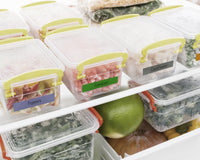Cafes, restaurants, and cafeterias all need to have an accessible, easy-to-follow food safety program. An effective program is concise and clear enough that new employees need few reminders of how to ensure food safety in the establishment. Color coding is among the best ways to keep your team on track and quickly identify any errors in your product organization and safety system. Let’s break down the importance of color coding your food safety program and provide a few examples of how to implement color coding in your workplace!
Color Coding Aids FIFO in the Food Industry
FIFO is a key term in the food industry that your team needs to know. First In, First Out (FIFO) is a food safety plan system that ensures team members use any perishable goods in a way that limits product expirations and spoilage. The first product that went in, now the oldest product in the fridge or on the shelf, is the one team members must use first.
FIFO is vital to the food industry as it avoids a variety of industry problems, from food waste to customer safety issues. Let’s talk about a few ways that FIFO affects the kitchen in practice and how color coding helps.
Confidence Is Key To Food Safety
FIFO solves a problem virtually unique to the food service industry. No customer wants to dine in a restaurant where staff ever look at an ingredient and must ask, “Is this good anymore?” Not only should all ingredients have proper labeling of expiration dates or cook dates, but the FIFO system keeps commonly used ingredients that frequently get restocked from getting wasted.
Using color-coded labeling to date products as you place them into the fridge makes it that much easier to know when a product was stored and if the FIFO system is moving as expected. Knowing that your entire team adheres to the FIFO system ensures that ingredients need only a quick check to give you the confidence to serve customers food that you know is safe.
Keeping a Clean Kitchen
An added benefit of implementing an easy-to-spot color-coded FIFO system in your restaurant or cafeteria is that organization leads to a cleaner kitchen. If products are labeled using our colorful day of the week labels, it’s easy to tell what’s sat too long at the back of the fridge with just one look. This aspect of FIFO becomes crucial when dealing with food that spoils, like milk and eggs. Moldy and rotten foods lead to a kitchen cleanup nightmare that slows down your operation and frustrates the entire team.
Color Coding Helps You Tell Products Apart
Color coding your products is an essential part of food safety as it clearly identifies which product is what. For businesses creating salad dressings, dessert fillings, or enclosed foods like breakfast tacos, a single-color coded label can make for all the difference. Labels make it easy to tell foods apart, so anything that is similar in appearance is easily separated and used appropriately. Not only does this food safety practice prevent sour cream from ending up where sugar icing should, but it also helps restaurants maintain menus that serve various dietary needs and restrictions.
Identifying All Allergens
Any food safety program must include a portion for allergens and allergy identification. Some allergens, such as peanuts or shellfish, provide a significant risk of cross contamination that color-coded labels could only do so much to prevent. However, for vegan, gluten-free, or non-dairy products, colored labels are key for quick identification and use.
Colored labels are a fantastic secondary or tertiary measure to protect your customers from potentially eating something hazardous to their health or in violation of their diet. Whether placed on the case or packaging, a brightly colored sticker makes the ingredients clear to everyone who handles the product. Chances increase, from the moment a product is wrapped to when it’s passed to the customer, that a team member will notice the label and ensure they’re handing out the right product.
Implementing a Food Safety Program With Color Coding
Food safety programs benefit from color coding in a number of ways, from increasing the efficiency of your inventory to ensuring your customers leave with the right food in hand. However, it is essential to implement color coding in your business with practicality in mind. Here are a couple of tips on proper implementation to help you set up new procedures:
Easy-To-Follow Food Safety Rubrics
Color coding increases the speed at which team members can effectively and accurately implement your business’ food safety rubrics and procedures. Next to a chart defining each label’s meaning and actionable steps, include a color dot or label on the chart itself. This way, team members do not have to guess what a blue or green label will look like as they seek it out. Providing an easy-to-reference visual aid in the inventory room, in the kitchen, and at the register also ensures that the entire team is conscious of the food safety program codes.
Usable Labeling Tools
An important aspect to consider when implementing a food safety program with color coding is how willing your team members are to do it themselves. Boxes that are hard to open, labels that are hard to remove, and colors that are hard to tell apart all dissuade team members from adhering to food safety procedures. Remember to make instructions clear and invest in high-quality, easy-to-use labeling options that don’t slow your team down during the dinner rush.
When you’re ready to start color coding your food safety program, Chromalabel is ready to help! We offer a wide variety of commercial use colored labels for you to choose from, including color dots, various size rectangle labels, and day of the week labels. Bright, easy-to-notice neon colors ensure that your team doesn’t need to look hard to find the label no matter where it’s placed. Our shop also carries blank labels that are ideal for both laser and inkjet printers, and textured brown kraft labels that are easy to write on by hand.
If you don’t see the perfect label for your food safety needs in our selection, reach out to our team today! We’re happy to work with you and provide custom labels that suit your program’s needs.







